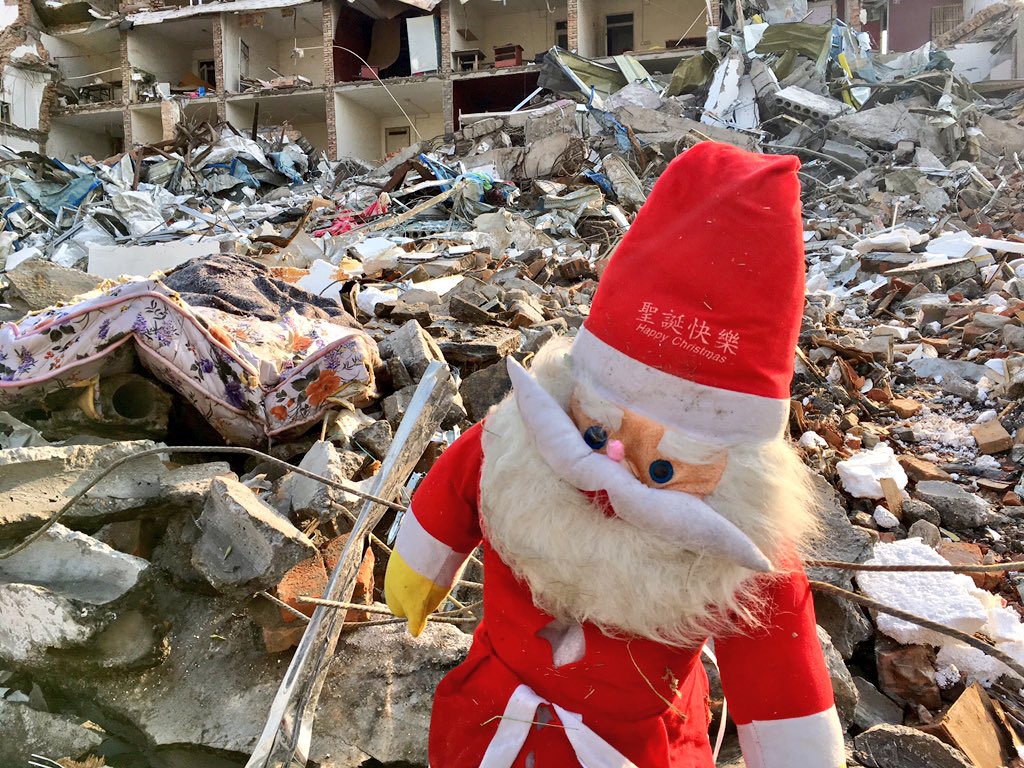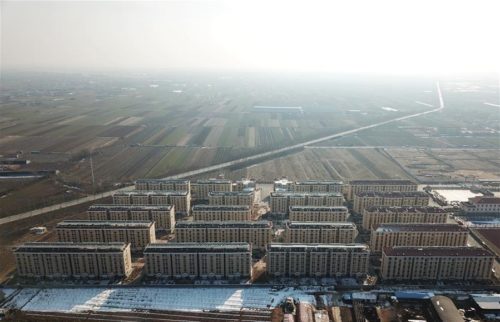The Santa of Xinjian Village, Beijing

Lan Jinghua 蓝京华 (Alain) spotted the giant Santa from a distance and was struck by its vivid colors, the doll’s redness amid the rubble of an urban village being emptied out and knocked down. “It stood out, and it attracted me,” he says.
It was a cold, clear Sunday in Xinjian Village 新建村, a shantytown whose obscurity was shattered last month when a fire killed 19 people. What followed was a hastily announced cleanup campaign in the name of safety, in which thousands of Beijing tenants on the edges of this hulking city, most of them occupying society’s lowest rungs, were evicted, ordered to abandon residences deemed illegal and/or marked, seemingly overnight, for demolition.
Lan, who is an artist living in the Songzhuang art colony, also on the outskirts of Beijing, took lots of photos of the Santa, some of which have been widely circulated online. “It was left by evictees, and it’s now impossible to find the original owners,” he says. “Maybe they returned to their hometowns, maybe they settled somewhere else in the city.
“After photographing [Santa], the reason we didn’t take him with us is because he has the right to remain. We implore anyone who sees him, please don’t take him away.”
Jady Liu, a college student, visited Xinjian that same evening and published a photo essay on this site. Santa, lending color to desolation, was among the most arresting images:
“Striking contrast,” Liu says. “I feel like Santa is supposed to represent safety, warmth, and happiness. But in Xinjian Village, he didn’t.”
Rebecca Davis, a reporter with Agence France-Presse, saw Santa the day after. As she tells it:
“We got there and we were sort of stopped by police from going closer to the scene, but you could climb through the rubble of one factory to this second story of a building already destroyed, and then over bricks. And then suddenly, I don’t know what I was expecting to see, but there was a vista of just complete demolition and chaos. I didn’t expect to see that at all, I was so surprised. Then, walking to find my photographer to see the rubble from around the front, I passed Santa.
“And I was like, ‘Oh, my god, China is wishing me Merry Christmas.’”
Merry Christmas!!!!!! XOXO, #China #eviction pic.twitter.com/0DOCRdbfFJ
— Rebecca Davis (@rebeccaludavis) November 27, 2017
“I just started laughing because it seemed like the most China thing,” Davis says, “to have a random, weird, kind of creepy Santa made of synthetic materials be the lone survivor of this crazy destruction, just standing there, watching.”
Weird, creepy, synthetic — maybe. But there is much to like about this version of Father Christmas. The fact that his fingers are stuffed inside oversized oven mitts. The fact that his handlebar mustache doesn’t match his neck beard. The fact that his jumbo platform boots may well have been designed by a cartoonist. Or that his hat says Happy Christmas.
Or how about this: his sheer size, his enormity:

Who was his owner? Where had he been stashed? What significance did he hold, occupying what must have been a disproportionate space in a tiny living quarter, to the people who woke every morning to his blue gaze?
“This Santa Claus in the ruins — a gigantic, colorful cloth doll…in one blink, people can see that in these ruins, not long ago, were objects of the living,” says Hu Minyi 胡敏怡, an art student. “People can feel the warmth and life previously on this inch of land, feel a trace of the breath and memories of the recently departed still in this patch of ruins.”

She adds, “The various holes in Santa’s body might well reflect the holes in the lives of those forced to move away.”
“He has become a symbol of holding fast, staying resolute,” says Lan, the artist. “Perhaps he is waiting for tenants to return. Perhaps he is a symbol of Beijing’s low-end population (低端人口 dī duān rénkǒu) — or is part of the low-end population himself, but he doesn’t want to leave.”
Witness to razing. Sentinel of a new day. Hope for restoration. Is the Santa of Xinjian — which literally means “new construction” — a symbol?
“Nah,” says Davis, the AFP reporter. “It’s just ironic, I guess, that the last man standing is Santa rather than the kind of people who make Beijing tick, whose labor actually contributes to making Beijing a great place and a functional place, and making all the clothes that we wear, that thousands of people wear. They’re all gone. There’s nobody.”
Xinjian is empty, as more urban villages on the fringes, beyond our everyday consciousness, might soon be. But St. Nick is still there, outliving the news cycle. I kind of hope he stays forever.
Of course, nothing is forever in modern China. Every object is liable to find itself on the wrong side of a bulldozer. When it comes to staying power, only the symbols have a shot.







